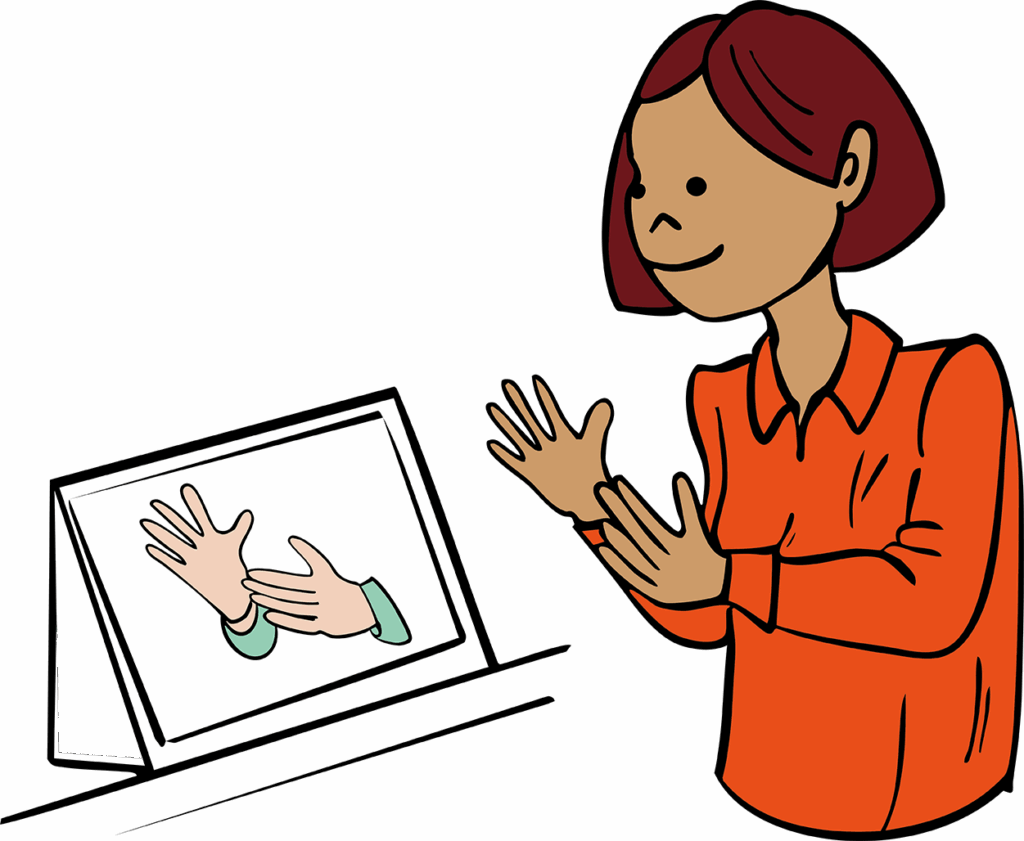Tutorial 7
Reading in DGS
Shared book reading is particularly good for supporting DGS acquisition. When you read in DGS, children’s signing vocabulary is expanded, and they learn new sentence structures. The pictures in the books help them to understand the language, and discussion following the reading supports their linguistic skills.
As DGS is a minority language, children will see it relatively rarely in their everyday environment. It is therefore particularly important to plan sufficient time for reading in DGS in daycare and early years settings, and in schools.

How to prepare for reading in DGS
Since there are few books available in DGS, you will have to use books with written text in German. Reading to your group then becomes a translation task.

Before you read, look up the most important words to find out how they are signed, and practise them. In the ReaDi picture books, the most important signs are provided. Signing dictionaries can also be helpful.
You can find a list of digital signing dictionaries here >

Decide how you wish to sign the characters’ names in DGS. Watch the ReaDi picture book DGS videos and take note of the signs for the characters.

Children’s access to, and mastery of, DGS can vary greatly. Adjust your signing to the skill level of your children.

How to give a vibrant reading in DGS
DGS is an independent language, which differs in structure from written German. Try to detach yourself from the written text and convey the content of the story in DGS.

Use facial expressions (e.g. to show emotions, or when switching characters). They are an important component of DGS stories. Decide where in the story you would like to use them.

Use your signing space like a theatre stage. Place the characters in a particular part of your signing space and refer to them while signing.
Each of the ReaDi picture books has a DGS interpretation. The videos will offer inspiration for reading and telling the story in a vibrant way. You can also find other picture books in DGS which you could use.
You can find a list of picture books using DGS videos here >

You use signs that are different from those used in the DGS video. How is this?

DGS has different dialects. A sign can vary according to region, just like in spoken German, or in other languages. This is not a problem. When you are reading, use the signs that you or the children are familiar with. Explain similar meanings or dialects to the children, so that they can discover the versatility of languages.
Your DGS skill level is not very high. How can you read in DGS?

Don’t give up reading in DGS: use all the signs and DGS grammatical structures that you know. Every sign helps the children’s understanding, and enables them to imitate.

Practise individual passages in the mirror. Film a reading session and discuss with colleagues how you could improve.

Invite deaf parents or other deaf adults to read the children a story in DGS. They are important linguistic role models.

Use interpreters for German and DGS. You could read aloud in German, and the interpreter can interpret into DGS. Discuss with the interpreter in advance how to structure the session so that everyone enjoys the reading.
You can also watch the DGS video of a picture book with the children. Be aware that:

The DGS videos may be too hard for children who are beginner learners of DGS, or are not accustomed to seeing DGS in two-dimensional videos. In this case, it is best that children do not watch the videos by themselves.

Introduce the children to the language in the DGS videos slowly. Show a section of the video first, then summarise the content, or clarify any questions the children have.

Decide whether you will read parts in DGS yourself, to match your language to the children’s abilities.

Stop the video and have the child repeat in DGS what has just happened. This will enable the child to better process what they have just seen, and practise their signing skills.

It will also enable you to verify whether the child has understood everything.

Children with a good command of DGS will be able to cope with the DGS videos alone. Give their parents the link to the ReaDi website, so that the children can also look at the books at home.



Tasks
Tasks

Choose a ReaDi book to read to the group. Watch the DGS videos, and the videos of individual signs. Decide which signs or sentences you wish to take responsibility for, and practise them in a mirror.

During your reading session, watch one or more DGS videos of the ReaDi picture books with one or more children. First, show the children a clip of the DGS video and then summarise the content, or allow the children to repeat what they have seen in their own words or signs.
